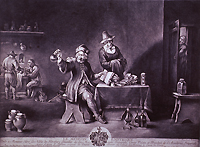The Medical Chemistry of the Paracelsians
As a replacement for the works of the ancients, Paracelsus and his followers consciously sought a new world system based upon the macrocosm-microcosm analogy. Chemistry was to be a key to this new philosophy which man was to uncover through new observations and the search for the divine signatures. This was unavoidable since a knowledge of the macrocosm led directly to hitherto unknown secrets of man.
There was clearly a practical side to all of this. The Grosse Wundartzney was a book dealing with specific medical problems as well as the preparation of balms and plasters that were widely heralded -- even among those who rejected Paracelsus' cosmological views. The chapters on the cure of wounds caused by gunshot clearly spoke to a growing problem in sixteenth-century medicine. But Paracelsus was aware of other current problems as well. In his Von der Bergsucht oder Bergkranckheiten drey Bücher (1533-34) he prepared the first book on miners' diseases -- indeed, it was the first book specifically on an occupational disease. And in his discussion of syphilis [Vom Holtz Guaiaco gründlicher heylung (1529) and Von der Französischen kranckheit Drey Bücher (1530)] he criticized current methods of treatment including the popular use of guaiac.
Works on specific medical problems were less inflammatory than concepts that seemed to directly challenge Galenic authority. Among the latter, Paracelsus' repeated use of chemistry and chemical analogies was particularly objectionable to the medical establishment. As an example one may turn to his conviction that each bodily organ acted as an alchemist separating pure from impure. Thus, the stomach separated the nutritional part of foodstuffs from the dross which was eliminated through the intestines. Similarly, other organs had their function in maintaining the health of the body. Illness occurred when the directive force in an organ failed and poisons accumulated. Examples were the tartaric diseases where stony precipitates developed in the kidneys or the bladder or -- as in the case of tuberculosis -- in the lungs.

Depiction of urine examination, Seventeenth Century. Print,
"Le Medecin Empyrique,"
by David Teniers, II, 1610-1690.
The essentially localized seats of diseases of the Paracelsians differed from the humoral explanations of the Galenists. Utilizing the ancient concept of the four humors (blood, phlegm, yellow and black bile) which were associated with the elements, the Galenists argued that health derived from a proper balance of these fluids while disease was the result of imbalance. The physician might note an excess of blood from a ruddy complexion, yellow bile through the yellowing associated with jaundice, black bile through diarrhoea, or phlegm from a running nose. Even uroscopy might be employed to diagnose an illness through a sample of urine without examining the actual patient since a humoral excess would be evident in the sample.
The Paracelsian rejection of humoral medicine was clearly a fundamental break with medical tradition. No less so was their method of cure. The Galenists argued that contraries cure. That is, a disease of a certain quality and magnitude would be cured by a medicine of opposed quality and magnitude. The Paracelsians turned rather to folk tradition arguing that like cures like: a poison in the body would be cured by a similar poison. And when the Galenists charged that the Paracelsians were a veritable legion of homicide physicians, the latter replied that their medicines were safe because they had been altered chemically; moreover, careful attention had been paid to dosage.
These medical reformers not only proposed a new approach to cure, they also emphasized a new class of materia medica. To be sure, some metallic and mineral substances had been employed by the ancients, but the great bulk of traditional remedies were derived from plant substances. This balance was to shift with the chemists who argued that the new and violent diseases of their age required stronger medicines. Neither the medieval herbals nor the works of the ancients described substances that could combat syphilis and other new diseases successfully. The internal use of metals and their compounds seemed essential to them. Used as purges and vomatives their action was truly more violent than the old herbal mixtures. In some cases the new medicines proved too strong and the Galenists accused their opponents with murder. When we examine the chemical and pharmaceutical books of the late sixteenth and the seventeenth centuries we see directions for the preparation of numerous compounds of mercury, lead, arsenic and antimony, almost all of which would be avoided today.

